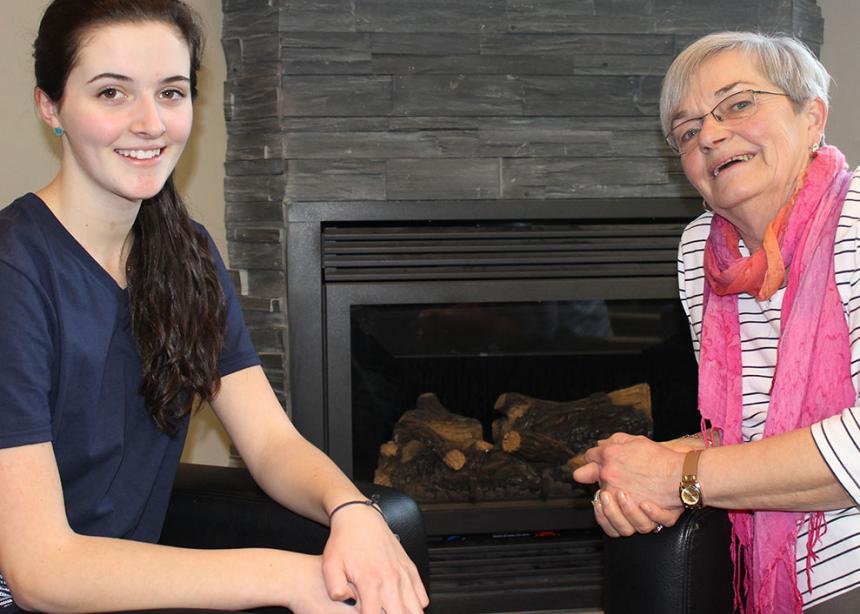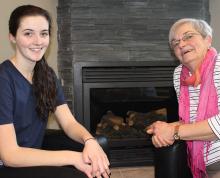It is not uncommon to hear people complain about the younger generation. But are today’s youth really all that different than youth of previous generations? Saskatoon grandmother Marlene Froese and her granddaughter Kenna Forrester don’t think so.
Froese grew up in Pleasant Point Mennonite Church in Clavet, Sask., where the young people’s group met weekly for choir practices and sang in church almost every Sunday. Summer choir practices included youth from Dundurn and Hanley Mennonite churches, which, together with Pleasant Point, formed the Nordheimer Gemeinde. Rehearsals culminated in a mass choir concert and picnic known as Gemeindefest.
In addition to singing, youth attended parties featuring circle games and dancing. They also met weekly for Sunday school, but not for mid-week Bible study, as some groups did.
“The Mennonites that settled that area came from a very liberal Russian congregation,” says Froese.
There were boundaries—dancing was permitted, alcohol was not—but young people knew where the boundaries were and did not cross them.
“No one ever felt that we would be destructive, that we would choose bad behaviour,” says Froese. “We just went to enjoy the socialization.”
Parties were held in one-room schoolhouses or in sheds or garages at members’ homes. Those who played instruments accompanied the dancing. Parties always followed weddings, but these were intergenerational affairs at which parents as well as youth enjoyed dancing and socializing.
Forrester’s family attends Nutana Park Mennonite Church in Saskatoon, where junior and senior youth meet each Tuesday evening and enjoy fun activities on weekends. There are no choir practices—Forrester is pretty sure the youth wouldn’t attend if there were—but they do engage in a broad range of learning, service and recreational activities, from creating videos on Mennonite history to go-carting and green Jell-O nights.
Most activities take place at the church. Not all attendees are from church families; some come at the invitation of a friend and have no prior church experience, but are included, nonetheless. Forrester appreciates that her church welcomes everyone regardless of race, age or sexual orientation. This makes her feel the youth are a vital part of the congregation.
Whereas Froese participated in youth activities with the same friends she’d grown up with, Forrester’s group is more diverse. But, Forrester maintains, “the church is always a community, no matter if [you’re with people you’ve known all your life] or you are meeting them for the first time.”
Froese agrees, saying that, although her generation didn’t talk about it, they certainly experienced community. “It wasn’t even a descriptor that we thought we had to use,” she says, “we were just together. Now we actually plan events that will bring us together.”
Froese believes today’s youth have the same need to be loved and accepted as her generation did. But the sense of belonging no longer just happens; it must be fostered.
Forrester adds that youth also need to know their church values them. Although she knows they are accepted, at times she feels they are “kind of put on the back burner.” She would welcome opportunities for the youth to take a greater role in congregational life, because, she says, “we need to show [the church] what we’ve been learning.”
Both grandmother and granddaughter were nurtured in loving church families with active youth groups. Yet their reflections reveal differences not in the nature of youth, but in the circumstances surrounding their experiences. The bond of community that once grew naturally from homogeneity and proximity must today be grown intentionally through inclusive activities and a welcoming spirit, within the youth group and the congregation as a whole.
That this seems to be Forrester’s experience is heartening, but is it true for youth in every church?
--Posted Feb. 12, 2014





Add new comment
Canadian Mennonite invites comments and encourages constructive discussion about our content. Actual full names (first and last) are required. Comments are moderated and may be edited. They will not appear online until approved and will be posted during business hours. Some comments may be reproduced in print.